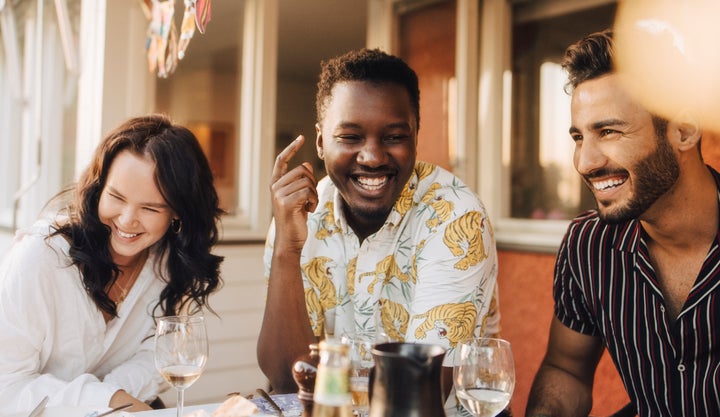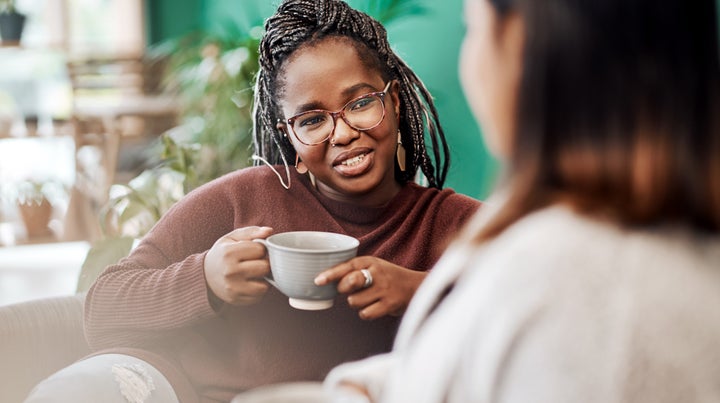Pre-pandemic, I used to see the same girl every Saturday morning at a strength training class at the gym. On a few occasions, we were paired up for the workout and exchanged greetings and small talk. From then on, we’d say “hi” and chat briefly when we saw each other. She seemed cool and I contemplated asking her if she ever wanted to get coffee or breakfast after class. But I talked myself out of it — I was worried the invitation might come across as weird. And I didn’t want to put myself out there.
Many adults bemoan the struggle of making new close friends in adulthood. One reason, according to West Los Angeles psychologist David Narang, is that people expect these bonds to form effortlessly as they did when they were younger.
“In childhood and often in early adulthood, we were thrown together daily with the same people for many hours in school, with unstructured time available afterward to talk or get together,” Narang, author of “Leaving Loneliness,” told HuffPost. “This repetition gave us a chance to vet each other through time and experience and allowed us to naturally gravitate toward those we felt comfortable with and curious about.”
As we get older, many of these organic opportunities start to dry up. Instead of sitting back and hoping an awesome new friendship will fall in our lap, it’s on us to put in some effort.
Is there an acquaintance in your life that you think would make a great friend? We have some expert-backed actionable advice to help make it happen.
Make plans with this person outside of the place you normally see them.
If it’s an acquaintance from yoga class, ask if they want to go to the farmers market. If it’s an Instagram friend you’ve been DMing back and forth with, invite them to go out to lunch. Basically, you want to change up the contexts in which you typically interact with this person, said Washington, D.C.-based psychologist and friendship expert Marisa G. Franco.
“Ultimately, the more sides of ourselves that we reveal to one another, the closer our friendships become,” she said. “And varying the contexts in which we interact allows us to surface the different sides of ourselves.”
“Ultimately, the more sides of ourselves that we reveal to one another, the closer our friendships become.”
- Marisa G. Franco, psychologist and friendship expert
You can think of it as “repotting” some of these casual friendships. Just as a plant requires a larger pot to continue growing, so too does a fledgling friendship.
“Sometimes you’ve got a friend at work, and you see them every day, but the pot that plant is in at work is quite small,” researcher Ryan Hubbard told The Atlantic. “It’s going to reach the size of the pot, and that’s it. If you want it to be a bigger, deeper friendship, you need to repot it to a bigger context. You might need to bring them to your house. Or invite them to meet your family — that’s an even bigger pot.”
These days, you can safely repot by “asking an acquaintance or work colleague on a socially distanced walk, or asking a neighbor to join you on a hike,” Franco said.
An alternative ― invite them to a group activity, if that’s more comfortable.
If you’re not ready for a one-on-one hangout yet, start by inviting the acquaintance to join you and a few others for a small group gathering.

“See if there is a fun activity you can begin with that person and a couple of others, such as a dinner, a golf game, sharing YouTubes over Zoom, or even getting a drink,” Narang said. “If it goes well, rally the group again when enough time has passed for everyone to be hungry for an encore.”
As you get to know this person better over time, it will start to feel more natural to make plans involving just the two of you.
Hang out with them consistently.
“Interacting regularly is how we both build and maintain our relationships,” Franco said. “This is, in part, due to a psychological phenomenon called the ‘mere exposure effect,’ where we tend to like people more as they become more familiar to us.”
You might benefit from creating a standing plan of some sort, like taking your dogs for a walk every weekend or meeting up for a virtual book club twice a month.
Find little ways to show you support them.
“People often think making friends is about being intriguing or smart or funny, but it’s actually more about making others feel valued and loved,” Franco said. “The more we can affirm others — through praising them, supporting them, getting excited at their accomplishments, showing gratitude for them — the closer our bonds will become. Whenever you have a positive thought about a friend, make sure you share it.”
Start to open up to them gradually.
It’s by being vulnerable — taking emotional risks and honestly sharing our insecurities, fears, struggles and mistakes — that we create meaningful, fulfilling relationships
“While we tend to think it’ll scare others away, research finds the opposite,” Franco said. “It makes others like us more, see us as more genuine, and feel closer to us. It also makes others feel safe to be vulnerable with us.”
That doesn’t mean you need to lay all of your cards on the table right away. But slowly opening up about smaller things and then bigger things over time can foster intimacy.

“If you overshare, you may have signaled that you are going to become too dependent upon the other person, destabilizing the friendship before it forms,” Narang said. “If you undershare, you may have shown that you will be excessively self-protective and that you are unwilling to take the risks required to become closer.”
Instead, start by volunteering something mildly personal, Narang said. You could, for example, talk about a flub you made at work that cost you a big sale. The other person will likely reciprocate by sharing a mistake they’ve made on the job.
“Then, hit pause, take the long view of the friendship and take your time,” he said. “If this seems to be going well, then one of you will bring up something more personal in a future conversation, and the other can again reciprocate.”
If the acquaintance is in a moment of need, see if you can help.
“If they are sick and need some medicine, or need a particular cable to be able to pull off a presentation the next day, or if they need advice about something you specifically have expertise in, this is a moment to stop what you are doing and provide,” Narang said.
It’s in these difficult moments that we notice — and remember — who showed up for us, Narang said, “and we instinctively feel more open to that person.”
Blissed Connections is an editorial series that explores practical ways to strengthen and deepen the relationships you have — or want to have — with the people in your life.